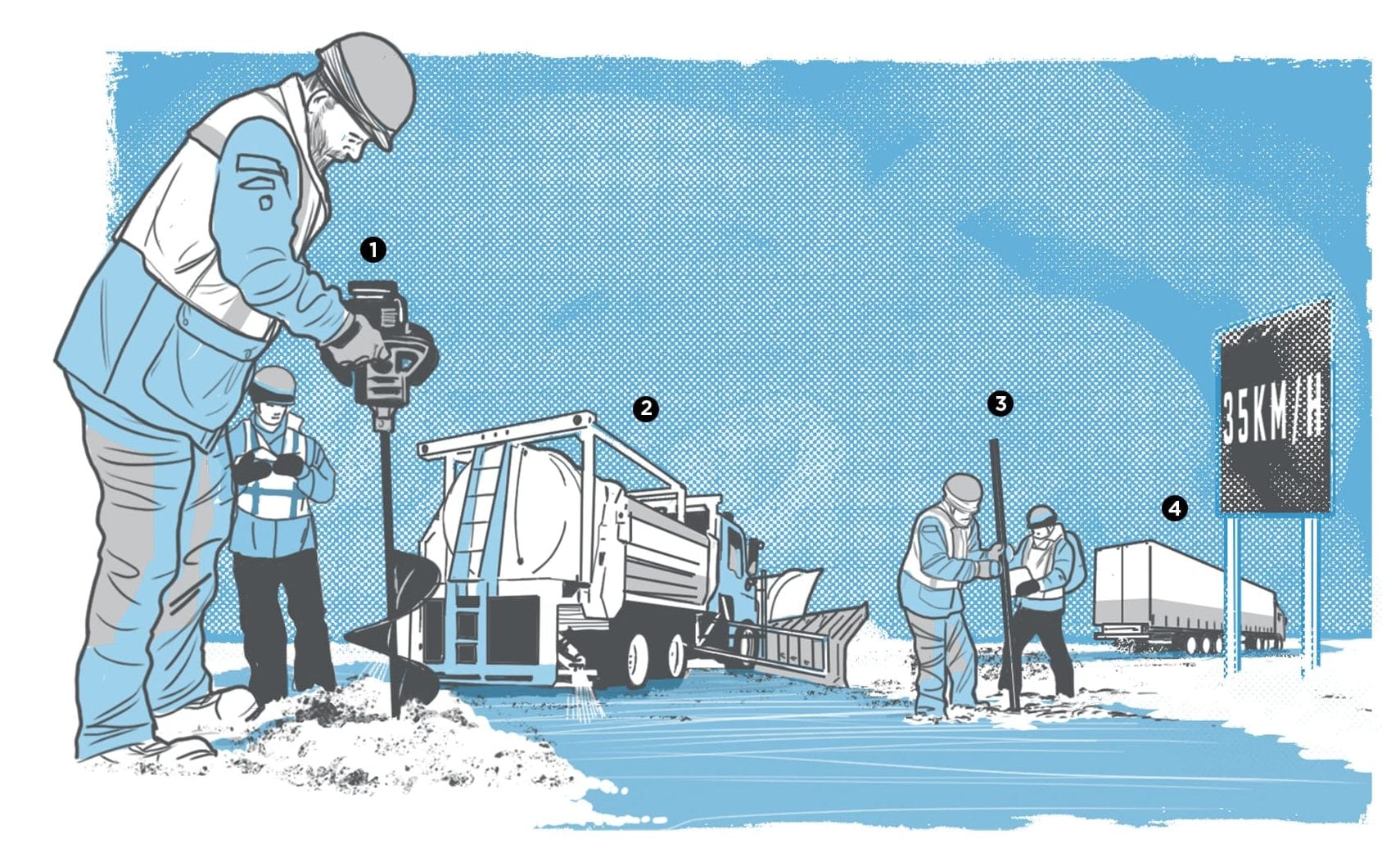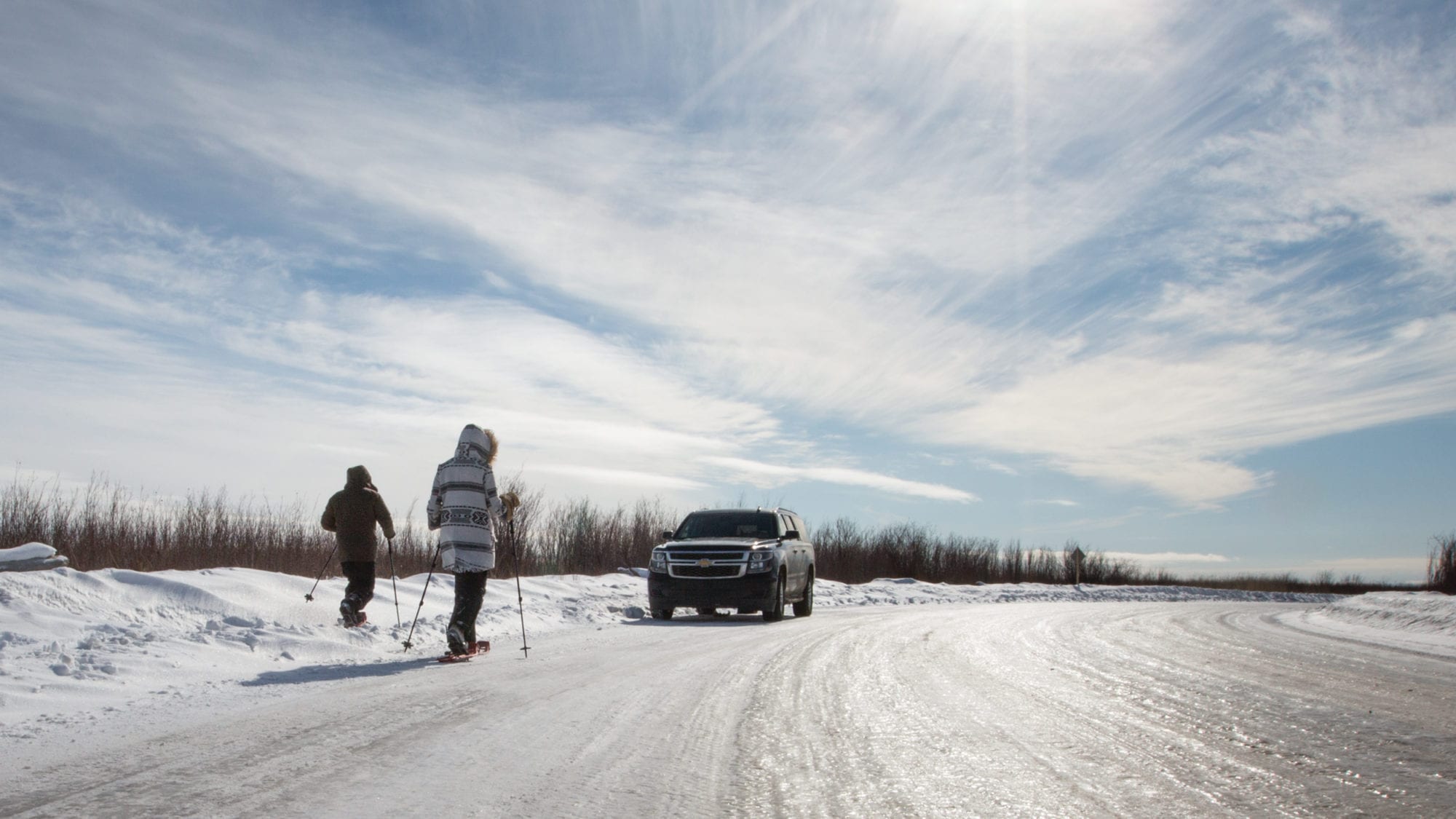Alberta ice roads (a.k.a. winter roads) are amazing feats of engineering and important lifelines to remote northern communities. Driving these seasonal roads is definitely not to be taken lightly, but if you’re well prepared and drive safely, there’s ample beauty to be discovered. And follow COVID-19 regulations, too: Do not travel if you are sick or have reason to believe you’ve been exposed to the coronavirus.
TIMELESS TOWN
Fort Chipewyan, Alberta’s oldest settled community, was once a thriving fur-trade hub. Indigenous peoples and European newcomers brought their goods by land and water, at the mercy of the rugged terrain. Nowadays, there’s just one way to get in or out of the 232-year-old hamlet if you’re on the ground: a winter road of hard-packed ice set atop the slushy tundra. Weather depending, from January through March, confident (and cautious) drivers can make the approximately 270-kilometre trip north from Fort McMurray to “Fort Chip,” potentially encountering moose, wolves, bears, and even herds of wild bison on the way. (But no gas stations, however.) The community itself is largely home to Cree, Dene and Métis peoples; their distinctive cultures come together with spectacular views of Lake Athabasca and the surrounding boreal forest.
MORE ADVENTURE
A 228-km winter road also runs north from Fort Chipewyan to Fort Smith, N.W.T., adjacent to Wood Buffalo National Park. The UNESCO World Heritage Site is home to endangered whooping cranes and the largest free-roaming wood bison herd in the world—not to mention massive salt plains, left behind by an ancient sea. The route to access this natural splendour can be treacherous, so ensure your vehicle is fueled up and in good working order, and that you’re prepared for cold-weather survival in case of a breakdown.
MORE TO READ
The coolest things to do in Yellowknife, Northwest Territories
GEAR UP
Make sure you’re well equipped for any trip on winter ice roads
• When driving on roads that are literally paved with ice, consider studded winter tires. The minuscule metal studs provide better traction
on slippery surfaces.
• Even if you’re confident in your vehicle, it doesn’t hurt to have extra supplies, like motor oil and gas-line antifreeze, to keep things running smoothly.
• If you have a breakdown, you’ll need to stay safe while waiting for aid. Pack warm clothes and boots, extra blankets or a sleeping bag, and lots of nourishing food.

HOW ALBERTA ICE ROADS ARE MADE
Alberta’s winter roads run across sandy tundra, muskeg quagmires and even a few frozen rivers. In many places they’re essentially thick, floating sheets of ice—and there’s a science to making them, says Emil Girard, who built winter roads out of Fort Chipewyan for more than 30 years. The exact methods are complex, and depend on temperature and terrain, but here’s the gist:
1. Planning: In November or December, workers begin monitoring ice depth along the planned route, using augurs and ground-penetrating radar.
2. Construction: On land, snow is plowed, the ground is graded and gradually flooded to create a roadway. A layer of snow is then applied and compacted for a smoother driving surface. Over water, ice must be at least 30 centimetres thick before snow is plowed. Exposed to freezing air, ice thickens, but crews also pump water onto the roadway to help it reach one metre in thickness—enough to support a tractor trailer.
3. Maintenance: Workers measure ice thickness daily, especially at river crossings, and fill any potholes that develop due to heavy traffic.
4. Safety: Speed limits top out at 35 km/h. Due to their weight, large trucks travelling too fast can create waves beneath the ice, which causes water to swell up and potentially crack the ice.
MORE TO READ
Our best advice for safer winter driving on rural roads
LIGHTS, CAMERA
Another reason Alberta’s far north is a winter wonderland? The aurora borealis. Locals say the mesmerizing light display is at its brightest during the winter months, and can be viewed from the late evening into the wee hours of the morning. For your best chance at photographing the northern lights, use a tripod-mounted camera with a wide-angle lens. On a clear night, setting your aperture to f/2.8 (or the lowest f number it can reach) and shutter speed between five and 25 seconds should work well.
TERRITORIES TRIP
Northern Alberta’s longest year-round paved road is the Mackenzie Highway (Hwy 35). Starting at Grimshaw, it makes for a truly epic, 1,000-kilometre road trip to Yellowknife, N.W.T., and its numerous historical, cultural and natural attractions. Past High Level, however, be aware that gas stations are few and far between, so plan ahead to avoid running out of fuel.
